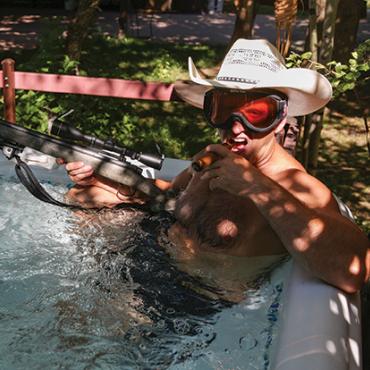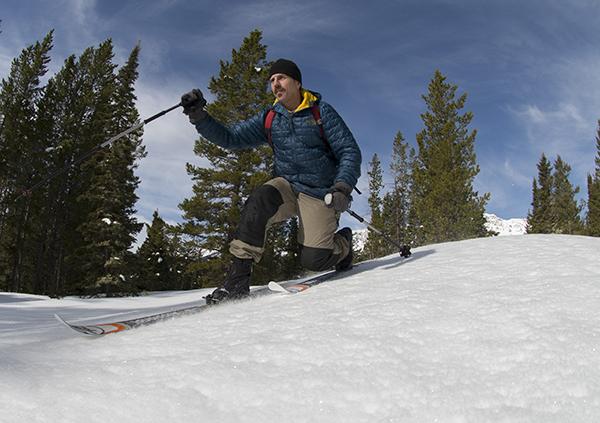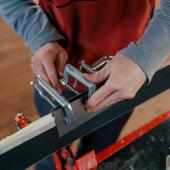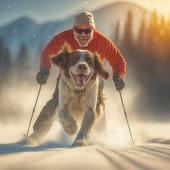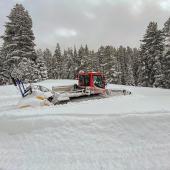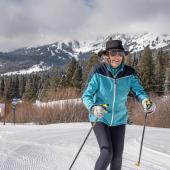Skinny Skis and Half-Grown Trees
A day at Mountain Meadows Guest Ranch.
Resting on my ski poles atop a small knoll, I survey the white-and-green landscape below, with its broad ravines and gentle, pine-flecked slopes. Between the trees, the layer of snow is thick and even, interrupted only by the occasional long and narrow profile of a fallen pine or fir. Right now, in the middle of January, it's hard to tell that Beaver Creek was once a massive clear-cut. Fifteen years after the logging trucks pulled out, it looks thin, young, and open—but it’s an alpine forest, to be sure, the kind that every Montanan knows and loves.
I’m here, at Mountain Meadows Guest Ranch in Big Sky, exploring the ranch’s extensive trail system on skis, with a group of writers and photographers who have come to Big Sky for an outdoor journalists’ convention. We’re all taking in the views for a minute before we head out into the rolling slopes and gentle canyons of the Beaver Creek drainage.
I wonder if my companions are thinking what I’m thinking, that nature’s resiliency is amazing and that winter is particularly beautiful in this juvenile forest surrounding us. From our vantage point above the lodge, we can see animal tracks on the slopes below, deep hoofprints weaving perfect S-turns through the intermittent, six-foot-tall pines. Grasses poke through the snow like reeds from a pond. All the old scars, all evidence of the forest's death a decade and a half ago, are concealed under a blanket of white. To the north, Lone Peak rises tall, its familiar, ashen face vaguely reassuring, like a faint light through a heavy fog. A deep stillness presides over everything—when someone breaks the silence to speak, we all jump.
“Ready to do this?” the guy next to me asks, his tone a bit tentative. I ask around, and sure enough, everyone's like me: plenty of enthusiasm, but no cross-country skiing experience whatsoever. After some last-minute stretching we head down the trail under the guidance of Jonathan Wiesel, a local writer and veteran skier of some thirty-odd years. Noticing his brightly colored, tight-fitting fleece get up, I’m tempted to make a wisecrack about seeing him in an L.L. Bean catalog. But I hold my tongue long enough to notice him pulling ahead in long, graceful strides, his deliberate sweeping motions propelling him smoothly over the snow. I’m here to learn how to ski, and this is the guy to teach me.
I move up behind him and mimic his movements. I quickly get the hang of it, and my body begins to move like his. I find my rhythm, extending my strides—each one perfectly executed, generating maximum propulsion with minimal effort. I feel good. I look behind me, and notice that everyone else is in the groove too. Our cadences become almost identical. We stop concentrating and just let our bodies make the motions. We look around, taking in the beauty and tranquility and letting it guide our movements, our pace, our breathing. As the preoccupations with the body's mechanisms wane, so does the awareness of its limitations. We can ski forever.
At the base of a decent-sized hill, we stop for a break, gathering in a tight circle, bonding instinctively in the silent wholeness of the moment. We’re all breathing hard, but energized; with beaming eyes and flushed cheeks we look around us and at each other and everyone’s smiling. A slight breeze rolls down the slope, and we instinctively turn our faces into it. One by one we close our eyes and take in the deep, earthy scent of fresh mountain pine. No one says a word.
Finally Jonathan breaks the spell with a “Let’s go!” and we all fall in behind him, skinning our way up the hill. After a few minutes our breathing begins to increase in volume and our pace slows. Even Jonathan’s strides look a little forced. A few of us begin to struggle, losing our balance as we fight the hill. “Cross-country skiing is a total-body workout,” he had told us earlier, and now we all know what he means. With each stride the lactic acid seeps in—we will all be sore tomorrow. But nobody stops; we simply adjust our bodies to the increasing demands of gravity and geography, and keep cruising along. At the top is a barn complete with old-style corral and several varieties of farm animals. We prop ourselves up against the corral for a much-needed rest.
After some water and chitchat with a friendly goat, we push off, back down the hill, taking an alternate loop to the south. Now our forward view is of Gallatin Canyon, its rugged walls steeped in snow, boulder, and pine. The Gallatin River gurgles its winter song as cars race down Highway 191.
We round a bend, the lodge comes into view, and by the subtle quickening of pace it’s obvious that everyone’s thinking about hot toddies on the back deck, with its comfy chairs and the best view of Lone Peak in the entire canyon. Jonathan skis up, his face flushed and his smile wide. There’s a gleam in his eye. “How about another loop before dinner?” he asks.
There is a moment’s hesitation, a momentary dilemma—and then we’re off, every one of us, slish-slishing into the half-grown, snow-covered pines.

